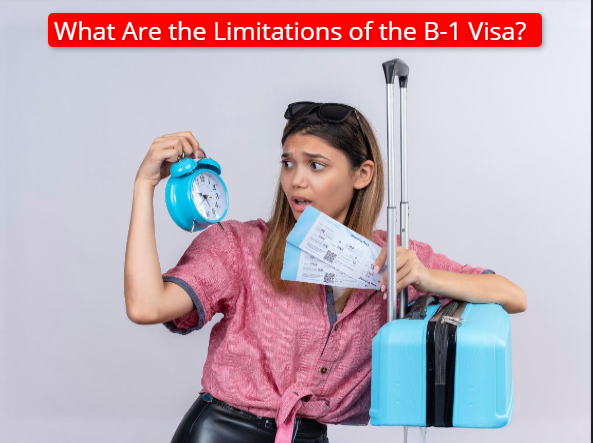The B-1 visa is a non-immigrant visa for individuals temporarily visiting the United States for business. Professionals who must do business including contract negotiations, conference attendance, or temporary training depend on this visa. Still, the B-1 visa has severe restrictions, particularly about generating income and employment.
This article will investigate a B-1 visa, what you can and cannot do with it, how to apply, and frequent misunderstandings including whether I can work in the US with a B-1/B-2 visa or the B-1 visa requirements.
What Is the Purpose of the B-1 Visa?
Those who want to visit the United States for official business travel on a B-1 visa. The visa prohibits employment in the United States or permanent residence.
For B-1 visa holders, permissible activities include:
- Attending seminars, conferences, or corporate meetings.
- Bargaining over commercial agreements.
- Communicating with company partners.
- Taking part in brief professional courses or training programs.
- Resolving litigations or settling estates.
Duration of the B-1 Visa
Usually, a B-1 visa grants six months to one year of validity. Extensions are possible, but you have to show a continuous need for your stay without breaking visa conditions.
What Are the Limitations of the B-1 Visa?
The B-1 visa has major limitations despite its advantages. Holders have to follow its intended purpose to stay out of violation and avoid deportation, or future refusal of visas.
-
No Employment Authorization

The prohibition of employment is the most visible restriction. Often asked questions include Can I work in the US with a B-1 visa or jobs in the USA for B-1/B-2 visa holders, however, the response is quite clear.
- For US-based businesses, you cannot participate in any kind of employment or money-generating activity.
-
No Salaries or Payments from U.S. Source
U.S. entities cannot pay holders a salary, compensation, or direct payment.
-
No Long-Term Stay or Residency
Usually lasting just six months, a B-1 visa is temporary with possible extensions. Penalties or bans may follow for overstaying.
-
No Change of Purpose
Without appropriate application and approval, holders cannot change to another visa type, such as an ORK or student visa.
-
Limited Scope of Activities
Activities have to exactly complement the intent of the visa. Misuse can lead to revocation and influence visa applications.
Can You Work with a B-1 Visa?

One of the most often misinterpreted questions is whether B-1 visa holders are allowed to work in the United States. The answer is no.
What Counts as Employment?
Employment is any activity carried out that involves:
- Performing duties for which one is compensated by a U.S.-based entity.
- Client freelance work done in the United States
Examples of Violations
- Accepting a work in the United States.
- Earning pay from a U.S. company.
- Participating in unauthorized employment, if unpaid.
How to Apply for a B-1 Visa
Use these guidelines to apply for a B-1 visa:
Step 1: Determine Eligibility
You have to demonstrate the following to qualify:
- A suitable justification for corporate travel.
- Ties to your home country including family, property, or work.
Step 2: Gather Documents

Among the necessary paperwork :
- • A six-month passport validity period following your visit.
- Form DS-160 (Non-Immigrant Visa Application).
- Photograph meeting U.S. visa requirements.
- Evidence of financial capacity to pay for your travel.
- Supporting records including
o Invitations letters.
o Training or conference registration.
o Business communication.
Step 3: Pay the Visa Fee
A B-1 visa requires payment of the application cost before an interview it is not refundable.
Step 4: Schedule and Attend an Interview

The consular officer at the U.S. Embassy or Consulate could ask:
- Why are you here?
- What is your intended duration of stay?
- What business activities will you perform?
Step 5: Wait for Visa Approval
If this is approved, the visa will be imprinted on your passport. Verify all the details before traveling.
How to Extend a B-1 Visa
File Form I-539 with the USCIS to request an extension if your American company needs more time. Usually, these records are needed:
- A letter explaining the extension’s reasons.
- Proof of stable finances to enable a longer stay.
- Evidence that your trip still fits the B-1 visa criteria.
Tips for Approval:
- File well before your existing visa runs out.
- Make sure the reason for the extension is convincing and fits the allowed activities.
What Happens If You Violate B-1 Visa Terms?
Violating the terms of a B-1 visa could have dire results including:
-
Immediate Visa Revocation
If U.S. officials find that you have broken the rules of your visa—that is, participated in unauthorized employment—your visa might be promptly withdrawn. This could happen on your current American trip or your next visit.
-
Deportation and Removal
Those found to have violated their B-1 status could be deported. Depending on the degree of the infraction, this process usually produces a bar on re-entry to the United States for a designated duration.
-
Future Visa Application Denials
Even little violations of Visa rules might have long-term effects. Often following such circumstances are questions like can I work in the U.S. with a B-1 visa or what is the B-1 visa USA’s strict rule for work? Past non-compliance is probably going to lead to denials for the next visa applications—including those related to employment or education.
-
Damage to Professional Reputation
Participating in unauthorized employment or overstaying a visa may damage your reputation in professional circles, particularly if your company’s operations require regular U.S. travel.
Steps to Transition from B-1 to Other Visa Categories

Later on, many business guests choose to stay longer or find jobs in the United States. Changing from a B-1 visa to another visa type is difficult, nevertheless, and requires strict respect for legal procedures.
Step 1: Identify an Appropriate Visa Category
- H-1B Visa: H-1B Visa is for qualified experts in specialized fields.
- L-1 Visa: For those moving inside companies.
- O-1 Visa: For those of exceptional talent or achievement.
Step 2: Apply for a Change of Status
File Form I-539 with U.S. Citizenship and Immigration Services (USCIS) to change. Supporting records comprise:
- Evidence of new visa eligibility.
- A thorough statement of intent clarifies the change’s reason.
Step 3: Await Approval
You cannot participate in illegal activity at this time. Simplifying the process could be achieved by leaving the United States and reapplying from your native country.
Tips for a Smooth B-1 Visa Experience
Use these ideas to optimize the advantages of your B-1 visa and stay clear of legal pitfalls:
- Document Everything: Always have the necessary paperwork on hand business invites, a return ticket, and evidence of financial stability.
- Respect Boundaries: Keep to acceptable activities like going to training courses or business meetings. Steer clear of work offers for USA B-1 visa holders
- Plan Your Exit Strategy: Before the visa runs out, schedule leaving the United States. Apply for an extension far well ahead if you need more time.
- Be Transparent with Immigration Officers: Clearly state the reason you are visiting immigration offices. Misrepresentation could cause instant denial of access.
Consult an immigration attorney if you are unclear about visa limitations.
Conclusion
Though it comes with clear restrictions, the B-1 visa is a useful resource for international business people. Ignoring or breaking its restrictions could have severe results including deportation or cancellation of a visa. Always follow the rules and, in case of doubt, consult an immigration counsel.
CTA: Simplify Passage Law-Based Immigration
Need help with U.S. immigration? Expert advice on visas, status adjustments, and more is provided by Passage Law. Get in touch now for customized help!







